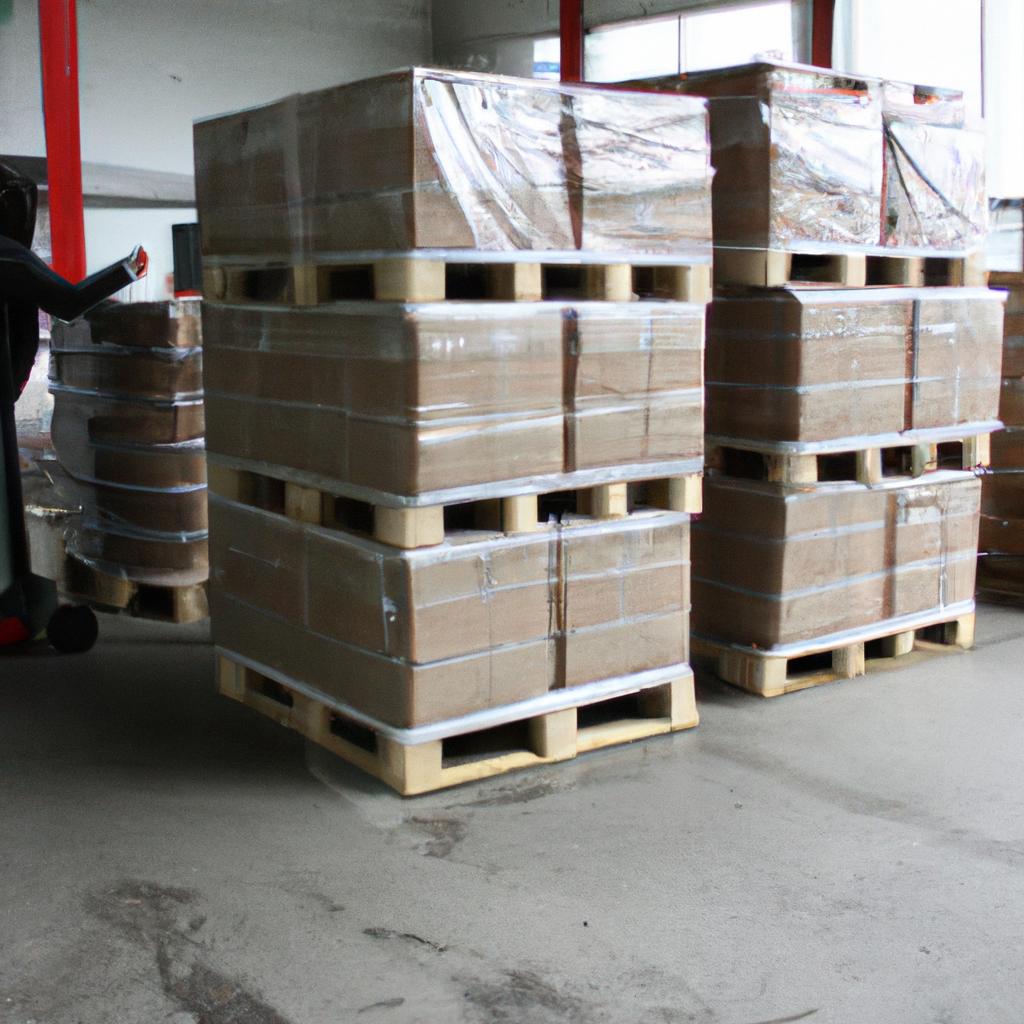Transportation planning plays a crucial role in supply chain optimization, ensuring the efficient movement of goods from manufacturers to end consumers. By strategically managing transportation activities, companies can minimize costs, improve customer satisfaction, and enhance overall operational performance. For instance, consider a hypothetical scenario where a global e-commerce company aims to deliver its products to customers across different regions within specified timeframes. Without effective transportation planning, the company may face challenges such as delayed deliveries, increased transportation costs, and dissatisfied customers. Therefore, understanding the key principles and strategies involved in transportation planning is essential for organizations seeking to streamline their supply chain operations.
In this comprehensive guide on transportation planning in supply chain optimization, we will explore various aspects related to this critical process. The first section will delve into the importance of transportation planning and its impact on overall supply chain efficiency. We will examine how optimizing transportation modes and routes can lead to cost savings and improved delivery times. Additionally, we will discuss the significance of selecting appropriate carriers based on factors such as reliability, capacity, and geographical coverage.
The second section will focus on key considerations when designing an effective transportation plan. Topics covered will include demand forecasting techniques, inventory management practices that align with transportation planning requirements, and leveraging technology solutions for real-time tracking and visibility of shipments. We will also discuss the role of collaboration and communication with stakeholders such as suppliers, manufacturers, carriers, and customers to ensure smooth coordination throughout the transportation process.
The third section will explore various strategies for optimizing transportation operations. This includes analyzing shipment characteristics and volume to determine the most suitable mode of transportation (e.g., trucking, rail, air, or sea). We will also discuss the benefits of using intermodal transportation and how it can help reduce costs and improve efficiency. Additionally, we will delve into route optimization techniques, including load consolidation, backhauling, and cross-docking to minimize empty miles and maximize resource utilization.
The fourth section will focus on performance measurement and continuous improvement in transportation planning. We will discuss key performance indicators (KPIs) that organizations can use to track their transportation performance and identify areas for improvement. These KPIs may include on-time delivery rates, transit time variability, cost per mile/kilometer, carrier performance metrics, and customer satisfaction scores. By regularly monitoring these metrics, companies can identify bottlenecks or inefficiencies in their transportation operations and take corrective actions accordingly.
Finally, we will touch upon emerging trends in transportation planning such as green logistics initiatives aimed at reducing carbon emissions through alternative fuel sources and sustainable packaging practices. We will also explore the growing importance of data analytics and artificial intelligence in enhancing decision-making capabilities within transportation planning.
Throughout this guide, we aim to provide insights into best practices and practical tips for effective transportation planning in supply chain optimization. By understanding the critical role of transportation in a company’s overall supply chain strategy and implementing appropriate planning techniques, organizations can achieve significant improvements in operational efficiency while meeting customer expectations.
Understanding Transportation Planning
Transportation planning plays a crucial role in optimizing supply chain operations. By efficiently managing the movement of goods, transportation planning ensures that products are delivered to customers on time and at minimal cost. To illustrate this concept, consider a hypothetical scenario where an e-commerce company needs to deliver its products from multiple warehouses located across the country to various customer locations within a tight timeframe. Effective transportation planning would involve determining the most optimal routes, selecting appropriate modes of transport, and coordinating schedules to ensure timely deliveries.
To better understand the intricacies of transportation planning, it is essential to recognize key factors that influence decision-making in this domain:
- Cost considerations: One primary objective of transportation planning is to minimize costs associated with shipping goods. Factors such as fuel expenses, labor costs, vehicle maintenance, and toll fees need careful consideration when developing transport strategies.
- Time management: Timely delivery is critical for customer satisfaction and maintaining competitive advantage. Efficient transportation planning involves effective scheduling and route optimization techniques to reduce transit times while ensuring prompt order fulfillment.
- Environmental sustainability: In today’s context of increasing environmental awareness and regulations, incorporating sustainable practices into transportation planning has become imperative. Strategies like using eco-friendly vehicles or consolidating shipments can help reduce carbon emissions and promote greener logistics solutions.
- Risk mitigation: The transportation process carries inherent risks such as accidents, thefts, delays due to weather conditions or traffic congestion. An effective plan should include risk assessment measures along with contingency plans to address unforeseen events swiftly.
| Factor | Description |
|---|---|
| Cost | Minimizing expenses related to fuel usage, vehicle maintenance, labor costs, and toll fees |
| Time Management | Balancing efficient scheduling with optimized routes for expedited order fulfillment |
| Sustainability | Incorporating eco-friendly vehicles and reducing carbon emissions |
| Risk Mitigation | Assessing potential hazards during transport and implementing contingency plans |
Understanding these factors is crucial for effective transportation planning. By considering cost, time management, sustainability, and risk mitigation strategies, organizations can develop comprehensive transport strategies that optimize their supply chain operations.
Transitioning into the subsequent section on “Key Factors in Transportation Planning,” it becomes evident that a thorough understanding of these key factors will enable us to delve deeper into the critical aspects that shape successful transportation planning outcomes.
Key Factors in Transportation Planning
Section H2: Understanding Transportation Planning
Transportation planning plays a crucial role in optimizing supply chains, ensuring the smooth flow of goods from their point of origin to their final destination. To further explore this topic, let us delve into key factors that influence transportation planning decisions.
One important factor is the geographical layout and infrastructure of the areas involved in the supply chain. For instance, consider a hypothetical scenario where a manufacturing company needs to transport its products from its plants located in different regions to various distribution centers across the country. The decision on which routes to use and how to allocate resources would depend on factors such as road conditions, traffic congestion, distance between locations, availability of alternative modes of transportation (e.g., rail or air), and proximity to major highways or ports.
Another critical consideration for effective transportation planning is cost optimization. Companies strive to minimize costs while maintaining service levels by strategically selecting carriers and modes of transportation. This involves analyzing multiple variables such as freight rates, fuel prices, labor costs, maintenance expenses, and any taxes or tolls associated with specific routes or modes. By carefully considering these aspects, companies can make informed decisions that balance cost-efficiency with meeting customer demands.
To better illustrate the impact of transportation planning on overall supply chain performance, consider the following bullet points:
- Efficient transportation planning reduces lead times and delivery delays.
- Effective route optimization minimizes empty miles traveled by vehicles.
- Selection of appropriate carriers enhances reliability and consistency.
- Utilization of advanced technologies improves visibility and tracking capabilities.
Moreover, an essential tool used in transportation planning is forecasting demand patterns accurately. By understanding historical data trends and predicting future requirements based on market analysis, companies can anticipate fluctuations in demand and adjust their transportation strategies accordingly. This enables them to optimize resource allocation and ensure timely deliveries even during peak periods or unexpected events.
In the subsequent section about “Types of Transportation Modes,” we will explore different options available for businesses when choosing suitable transportation modes for their supply chain operations. Understanding these modes is vital as they directly impact the efficiency, cost-effectiveness, and overall success of transportation planning efforts.
Types of Transportation Modes
Section H2: Key Factors in Transportation Planning
Transportation planning plays a pivotal role in optimizing supply chain operations. By carefully considering various factors, companies can make informed decisions that maximize efficiency and minimize costs. In this section, we will explore the key factors that influence transportation planning in supply chain optimization.
One example of how these factors impact transportation planning is the case of Company XYZ, a global retailer with multiple distribution centers across different regions. To meet customer demands while minimizing costs, they must consider several crucial elements:
- Distance: The proximity between suppliers, production facilities, warehouses, and customers significantly impacts transportation planning. Minimizing distance helps optimize delivery time and reduce fuel consumption.
- Capacity: Assessing the capacity requirements for each mode of transport is vital to ensure efficient utilization of resources. Companies need to evaluate whether their goods can be transported more effectively through trucking, rail, air freight or ocean shipping.
- Cost: Analyzing transportation costs involves considering not just the direct expenses associated with moving goods but also indirect costs such as inventory carrying charges or penalties for late deliveries.
- Reliability: Ensuring reliable transportation services minimizes disruptions in the supply chain and enhances customer satisfaction. Evaluating carriers based on their performance metrics and track record becomes imperative.
To illustrate how these factors interplay in real-world scenarios, let’s examine Company XYZ’s decision-making process using a table:
| Factor | Trucking | Rail | Air Freight | Ocean Shipping |
|---|---|---|---|---|
| Distance | Short | Moderate | Long | Long |
| Capacity | High | High | Low/Medium | High |
| Cost | Medium | Low | High | Low |
| Reliability | High | Moderate | Moderate/High | Moderate |
By evaluating these factors for each transportation mode, Company XYZ can make informed decisions to optimize their supply chain operations. The table clearly demonstrates that trucking is the most suitable option for short-distance shipments due to its high capacity and reliability. On the other hand, ocean shipping emerges as a cost-effective choice for long-distance deliveries with relatively low urgency.
Considering these key factors in transportation planning enables companies like Company XYZ to streamline their supply chains effectively. By making informed decisions based on distance, capacity, cost, and reliability, they can achieve efficient movement of goods while meeting customer demands promptly.
The subsequent section will delve into another crucial aspect of transportation planning: optimizing route selection. Understanding how different routes impact overall logistics efficiency is essential for maximizing the effectiveness of supply chain operations.
Optimizing Route Selection
Transitioning from the previous section on different types of transportation modes, it is essential to explore the process of optimizing route selection within transportation planning. This aspect plays a crucial role in supply chain optimization as it directly affects cost-efficiency and timely delivery. To illustrate this concept further, let us consider an example involving a multinational retail company that sources products from various manufacturers across the globe and distributes them to their regional warehouses.
Optimizing route selection involves determining the most efficient routes for transporting goods based on factors such as distance, road conditions, traffic patterns, and delivery requirements. By carefully analyzing these variables, companies can enhance their logistics operations by reducing transport costs, minimizing fuel consumption, and improving overall customer satisfaction through faster deliveries.
To facilitate decision-making in route selection optimization, consider the following key points:
- Geographic Information Systems (GIS): Utilizing GIS technology allows companies to map out potential routes while considering real-time traffic data, weather conditions, and other relevant information.
- Optimization Algorithms: Sophisticated algorithms can be employed to calculate optimal routes based on multiple factors simultaneously.
- Integration with Warehouse Management Systems (WMS): Aligning route selection with WMS enables seamless coordination between inventory levels at warehouses and planned transportation schedules.
- Collaboration among Stakeholders: Effective collaboration between shippers, carriers, drivers, and customers ensures smooth execution of optimized routes.
Table 1 below provides a simplified example highlighting how optimizing route selection can impact supply chain efficiency:
| Criteria | Traditional Approach | Optimized Approach |
|---|---|---|
| Distance Travelled | Longer | Shorter |
| Delivery Time | Inconsistent | Consistent |
| Fuel Consumption | Higher | Lower |
| Cost per Mile | Expensive | Economical |
By employing optimization techniques in selecting suitable transportation routes, companies can significantly improve their supply chain performance. This, in turn, leads to enhanced cost savings, reduced environmental impact, and improved customer satisfaction.
Transitioning into the subsequent section on Effective Inventory Management, it is crucial to understand how optimizing route selection interacts with other aspects of supply chain management. By integrating these various elements seamlessly, companies can achieve a holistic approach towards achieving operational excellence and maximizing overall efficiency.
Effective Inventory Management
It ensures that goods are delivered efficiently and on time, minimizing costs and maximizing customer satisfaction. However, another critical aspect of supply chain optimization lies in effective inventory management. By strategically managing inventory levels, businesses can minimize holding costs while ensuring sufficient stock availability to meet customer demands.
To illustrate the significance of effective inventory management, let’s consider a hypothetical scenario involving a retail company. This company operates multiple stores across different regions and relies heavily on timely replenishments from its distribution centers. Inefficient inventory management could result in overstocking at some locations while leading to stockouts at others. These issues may lead to increased carrying costs due to excess inventory or lost sales opportunities due to insufficient stock.
To achieve effective inventory management, several key strategies can be implemented:
-
Demand forecasting: Accurate demand forecasting is crucial for determining optimal inventory levels. By analyzing historical data, market trends, and other relevant factors, businesses can project future demand more accurately and adjust their inventory accordingly.
-
Safety stock optimization: Maintaining safety stock helps mitigate unexpected fluctuations in demand or supply disruptions. It acts as a buffer against uncertainties but should be optimized carefully to avoid excessive holding costs.
-
Just-in-time (JIT) approach: Implementing JIT principles enables companies to reduce their inventory levels by receiving goods just when they are needed rather than maintaining large inventories for extended periods.
-
ABC analysis: Classifying items based on their value allows businesses to prioritize their attention and resources accordingly. High-value items with low-demand variability may require tighter control compared to low-value items with high-demand variability.
- Reduced carrying costs
- Minimized risk of obsolescence
- Enhanced operational efficiency
- Improved customer service levels
Additionally, we present a three-column table showcasing the impact of effective inventory management on key supply chain metrics:
| Supply Chain Metric | Impact of Effective Inventory Management |
|---|---|
| Cost | Decreased carrying and obsolescence costs |
| Efficiency | Enhanced operational efficiency |
| Customer Satisfaction | Improved service levels |
Looking ahead to the subsequent section on technology solutions for transportation planning, it becomes evident that optimizing route selection and effective inventory management are interconnected components in achieving overall supply chain optimization. By leveraging technology solutions, businesses can streamline their transportation planning processes while integrating them with efficient inventory management strategies.
[Transition sentence into subsequent section: Technology Solutions for Transportation Planning] Through the adoption of advanced software systems and data analytics tools, companies can gain valuable insights and make informed decisions regarding optimal routes, inventory levels, and more.
Technology Solutions for Transportation Planning
Section H2: Technology Solutions for Transportation Planning
Effective transportation planning is crucial in optimizing supply chain operations. With the advancement of technology, various solutions have emerged to enhance transportation efficiency and streamline logistics processes. This section explores some key technology solutions that can be utilized in transportation planning.
One example of a technology solution for transportation planning is the implementation of advanced routing software. This software uses algorithms to optimize delivery routes based on factors such as distance, traffic conditions, and vehicle capacity. By analyzing real-time data, it enables companies to make informed decisions regarding route selection, leading to reduced fuel consumption, improved delivery times, and increased customer satisfaction.
In addition to advanced routing software, another technology solution gaining prominence in transportation planning is the use of telematics systems. These systems collect real-time data from vehicles through sensors and GPS tracking devices. The collected information includes vehicle speed, fuel consumption, maintenance needs, and driver behavior. By leveraging this data, companies can monitor fleet performance, identify areas for improvement, and implement proactive measures to minimize disruptions and ensure efficient operations.
- Reduced carbon emissions: Implementing optimized routing software helps decrease fuel consumption by minimizing unnecessary miles traveled.
- Enhanced customer experience: Utilizing telematics systems allows for accurate tracking of shipments and timely updates on delivery status.
- Improved operational visibility: Real-time data collection provides insights into fleet performance metrics like driver productivity and asset utilization.
- Cost savings: Optimized routes lead to lower fuel costs while predictive maintenance enabled by telematics prevents expensive breakdowns.
Furthermore, a comparative analysis table showcasing different technology solutions’ features can help readers gain a comprehensive understanding of their merits:
| Technology Solution | Features |
|---|---|
| Advanced Routing Software | – Algorithm-based route optimization – Real-time traffic monitoring – Vehicle load balancing |
| Telematics Systems | – GPS tracking for real-time vehicle location – Sensor-based data collection – Driver behavior monitoring |
In conclusion, technology solutions play a crucial role in transportation planning within the supply chain. Advanced routing software and telematics systems offer valuable tools to optimize delivery routes, improve fleet performance, and enhance customer satisfaction. By embracing these technologies, companies can achieve operational efficiencies while reducing costs and environmental impact.











